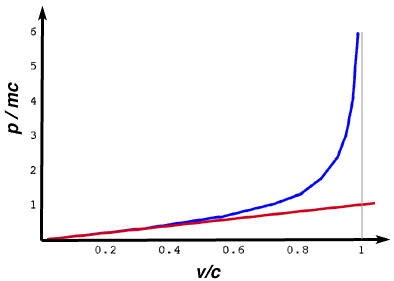Classically, the momentum was defined as the product of velocity and mass:
Since we have seen that the speed cannot exceed c, this implies that the definition of momentum will either have to be changed or that there is a maximum momentum that is possible for a given particle. It turns out that the first is the case.
 The
relativistically correct definition of the momentum is
The
relativistically correct definition of the momentum is
where m is the mass of the particle (as measured in a frame where the particle is at rest).
In the graph on the right we compare the two formulas for the momentum to each other. In blue we show the correct formula, and in red the classical approximation. The velocity is shown in units of c, and the momentum in units of mc. You can see that up to speeds of c/2 or so the two formulas give pretty much the same result, but then the relativistically correct momentum goes to infinity as v approaches c.
Newton's Second Law is as ever
|
|
|
|
|
|
|
|
where ![]() is the relativistic momentum.
is the relativistic momentum.

© MultiMedia Physics 2000